圈闭评价
- 格式:pdf
- 大小:1.11 MB
- 文档页数:80
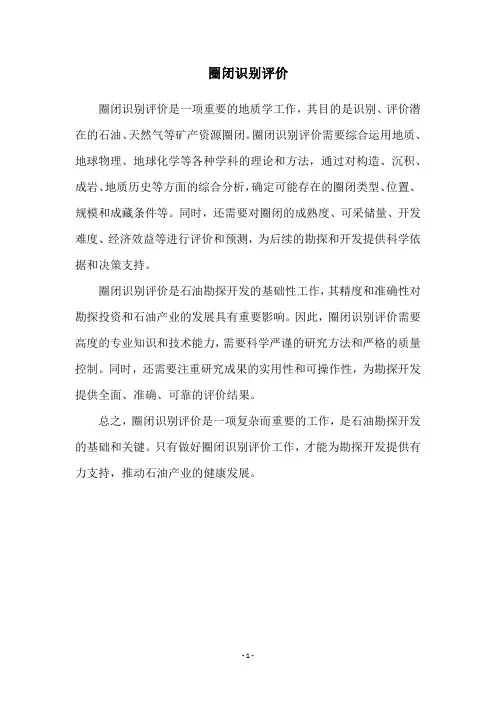
圈闭识别评价
圈闭识别评价是一项重要的地质学工作,其目的是识别、评价潜在的石油、天然气等矿产资源圈闭。
圈闭识别评价需要综合运用地质、地球物理、地球化学等各种学科的理论和方法,通过对构造、沉积、成岩、地质历史等方面的综合分析,确定可能存在的圈闭类型、位置、规模和成藏条件等。
同时,还需要对圈闭的成熟度、可采储量、开发难度、经济效益等进行评价和预测,为后续的勘探和开发提供科学依据和决策支持。
圈闭识别评价是石油勘探开发的基础性工作,其精度和准确性对勘探投资和石油产业的发展具有重要影响。
因此,圈闭识别评价需要高度的专业知识和技术能力,需要科学严谨的研究方法和严格的质量控制。
同时,还需要注重研究成果的实用性和可操作性,为勘探开发提供全面、准确、可靠的评价结果。
总之,圈闭识别评价是一项复杂而重要的工作,是石油勘探开发的基础和关键。
只有做好圈闭识别评价工作,才能为勘探开发提供有力支持,推动石油产业的健康发展。
- 1 -。
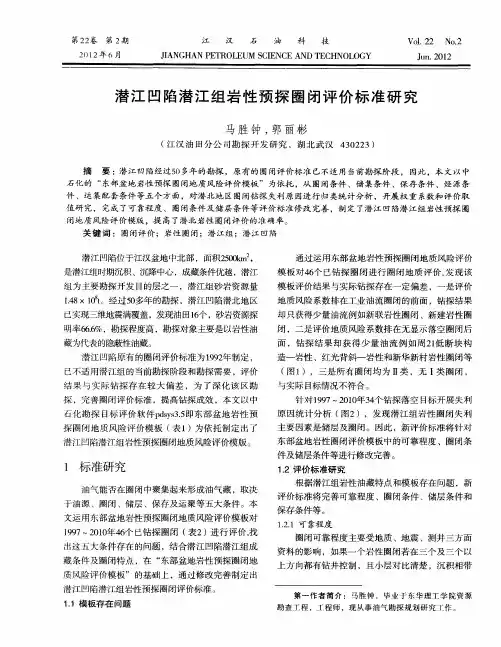
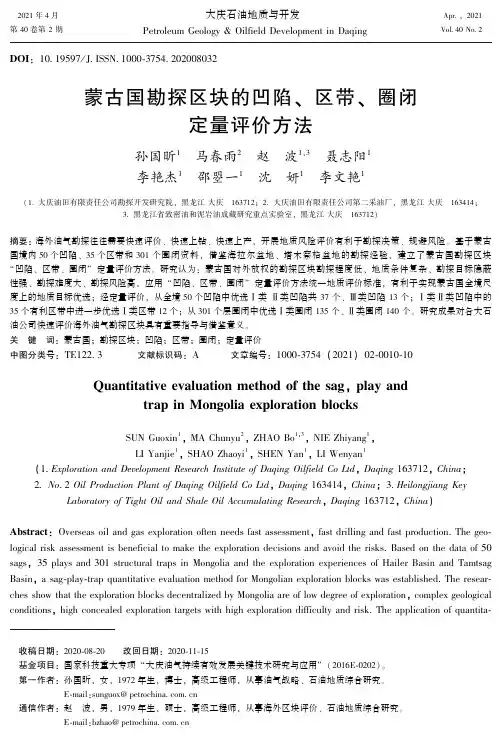
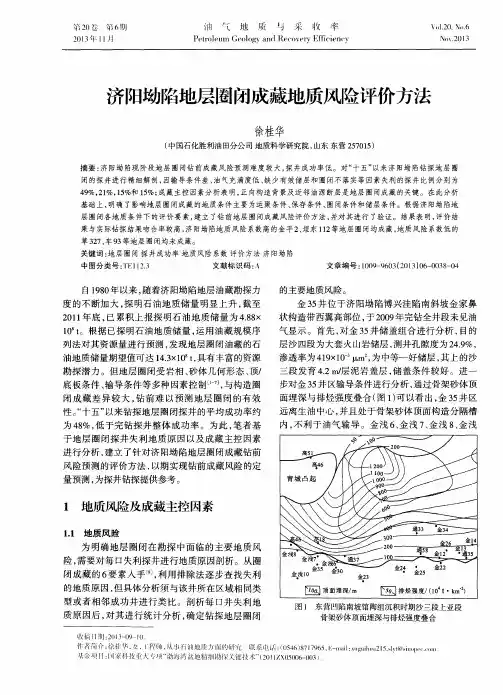
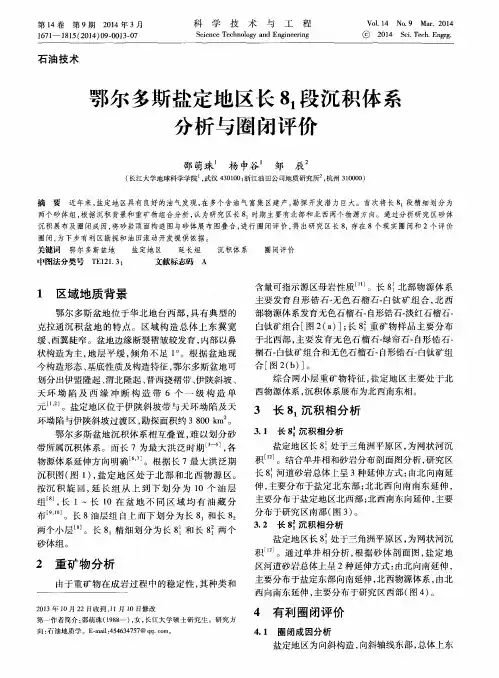
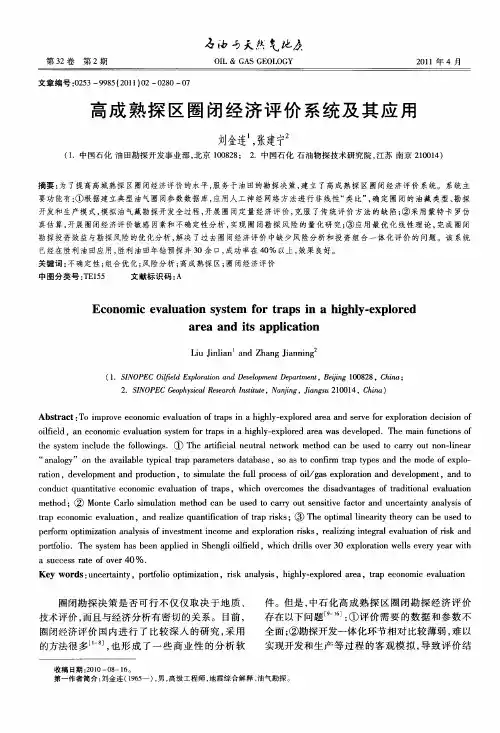
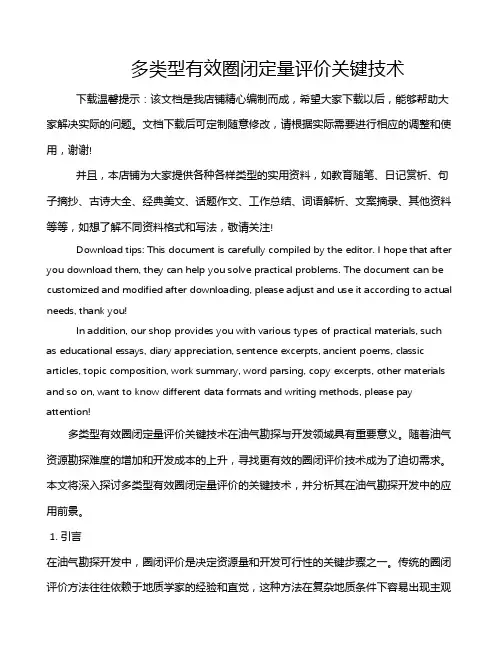
多类型有效圈闭定量评价关键技术下载温馨提示:该文档是我店铺精心编制而成,希望大家下载以后,能够帮助大家解决实际的问题。
文档下载后可定制随意修改,请根据实际需要进行相应的调整和使用,谢谢!并且,本店铺为大家提供各种各样类型的实用资料,如教育随笔、日记赏析、句子摘抄、古诗大全、经典美文、话题作文、工作总结、词语解析、文案摘录、其他资料等等,如想了解不同资料格式和写法,敬请关注!Download tips: This document is carefully compiled by the editor. I hope that after you download them, they can help you solve practical problems. The document can be customized and modified after downloading, please adjust and use it according to actual needs, thank you!In addition, our shop provides you with various types of practical materials, such as educational essays, diary appreciation, sentence excerpts, ancient poems, classic articles, topic composition, work summary, word parsing, copy excerpts, other materials and so on, want to know different data formats and writing methods, please pay attention!多类型有效圈闭定量评价关键技术在油气勘探与开发领域具有重要意义。
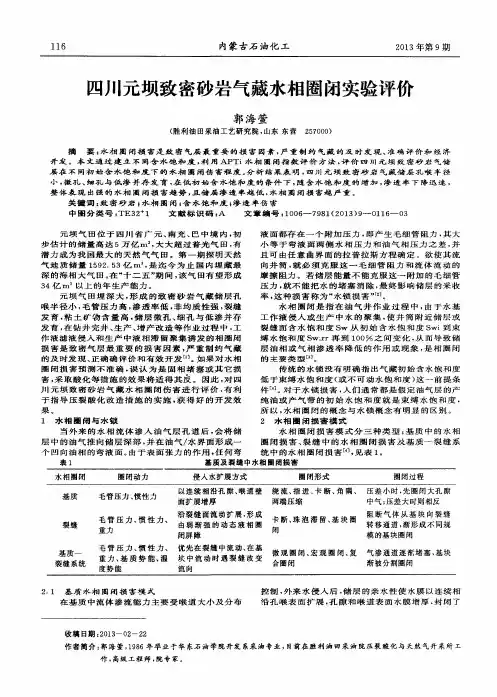
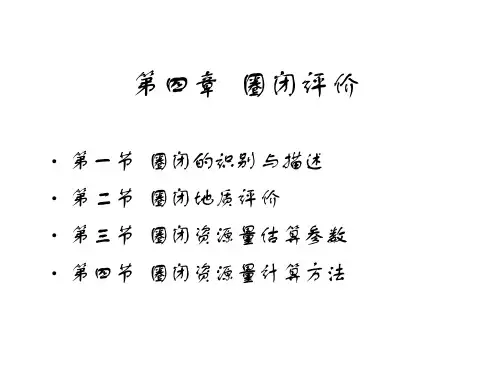
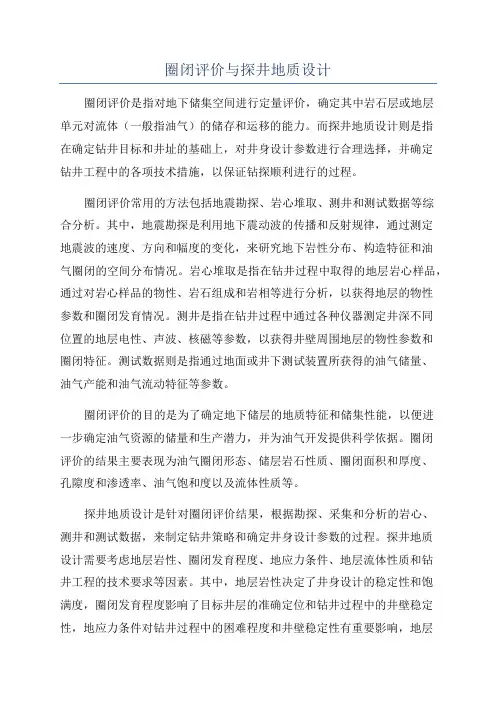
圈闭评价与探井地质设计圈闭评价是指对地下储集空间进行定量评价,确定其中岩石层或地层单元对流体(一般指油气)的储存和运移的能力。
而探井地质设计则是指在确定钻井目标和井址的基础上,对井身设计参数进行合理选择,并确定钻井工程中的各项技术措施,以保证钻探顺利进行的过程。
圈闭评价常用的方法包括地震勘探、岩心堆取、测井和测试数据等综合分析。
其中,地震勘探是利用地下震动波的传播和反射规律,通过测定地震波的速度、方向和幅度的变化,来研究地下岩性分布、构造特征和油气圈闭的空间分布情况。
岩心堆取是指在钻井过程中取得的地层岩心样品,通过对岩心样品的物性、岩石组成和岩相等进行分析,以获得地层的物性参数和圈闭发育情况。
测井是指在钻井过程中通过各种仪器测定井深不同位置的地层电性、声波、核磁等参数,以获得井壁周围地层的物性参数和圈闭特征。
测试数据则是指通过地面或井下测试装置所获得的油气储量、油气产能和油气流动特征等参数。
圈闭评价的目的是为了确定地下储层的地质特征和储集性能,以便进一步确定油气资源的储量和生产潜力,并为油气开发提供科学依据。
圈闭评价的结果主要表现为油气圈闭形态、储层岩石性质、圈闭面积和厚度、孔隙度和渗透率、油气饱和度以及流体性质等。
探井地质设计是针对圈闭评价结果,根据勘探、采集和分析的岩心、测井和测试数据,来制定钻井策略和确定井身设计参数的过程。
探井地质设计需要考虑地层岩性、圈闭发育程度、地应力条件、地层流体性质和钻井工程的技术要求等因素。
其中,地层岩性决定了井身设计的稳定性和饱满度,圈闭发育程度影响了目标井层的准确定位和钻井过程中的井壁稳定性,地应力条件对钻井过程中的困难程度和井壁稳定性有重要影响,地层流体性质则对井壁稳定和井液选择有一定要求,钻井工程的技术要求则决定了钻井过程中各项工程操作的选择和实施。
在进行探井地质设计时,需要综合考虑以上因素,并结合勘探工程和测试数据的评价结果,以确定合理的钻井目标、井口选择、井身设计参数和钻井工程措施。
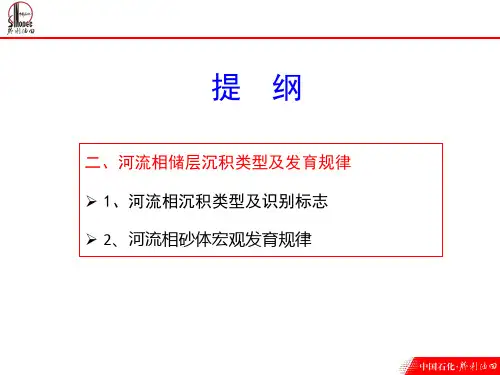
三合村洼陷地层圈闭具有倾角缓、隔层薄、含油高度低的特点,地层圈闭有效性评价是影响井位钻探成功率的关键。
勘探实践表明圈闭有效性主要受剥蚀点的准确识别、顶部盖层条件以及东营组内部隔层条件,本文旨在对三合村地区东营组剥蚀地层圈闭有效性评价方法进行总结,对滩海等地区地层圈闭的勘探部署中起到借鉴作用。
三合村洼陷位于沾化凹陷南部,是该区近两年的勘探热点。
该洼陷东营组主要沉积相为三角洲相,沉积物颗粒较细,主要为砂岩,粉细砂岩和泥岩,水缓坡带储层广泛发育,自北往南储层逐渐减薄尖灭,沿陈家庄凸起北坡横向上变化不大,储层条件比较落实。
一、剥蚀点准确描述方法剥蚀地层靠近剥蚀点时,地层逐渐减薄,不可避免地产生薄层干涉效应,因此不整合面对剥蚀点位置的反应会出现一定的偏差。
前人对此做过大量的研究,如苏朝光等依据地层剥蚀几何模型提出了夹角外推的方法,进一步提高剥蚀点描述的精度。
本区剥蚀圈闭除剥蚀层本身的影响之外,上覆地层也存在较大差异,从已钻井的情况来看,大致有泥岩、灰岩、砂岩以及砂泥岩薄互层四种盖层发育模式,增加了剥蚀点地震反射的复杂性,单纯利用夹角外推手段对不同盖层条件的圈闭剥蚀点识别效果仍有一定的多解性。
本次选用了NEWS软件的谐波拓频方法进行解释性处理,是根据地震层序体模型,通过连续分小波变换将地震信号分解在规定的主频范围内白化,按倍频分别乘在高频端和低频端进行延拓,得到延拓谐波,加强目标层调谐频率、加强地震信号中有效反射波的高频成分的地震处理技术,可有效提高地震识别能力。
在此基础上,结合瞬时相位剖面、视极性剖面等剖面,利用其连续性增强的特点,更容易把握剥蚀点。
二、盖层、隔夹层描述与评价1.盖层地震预测描述。
不整合上覆盖层条件可由不整合面上部反射波峰的反射振幅强弱以及频率、波形属性反应。
开取合适的时窗提取振幅、频率、波形三大类属性,进行多属性融合,预测盖层平面分布相带。
在井位控制下进行多属性拟合,构建对盖层变化反映更加敏感的复合属性进行盖层分布相带描述。